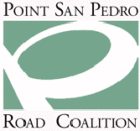The China Camp Road corridor (North San Pedro Road, or NSPR, through China Camp) is our residents’ primary “lifeline” for evacuation and emergency response in the event that Point San Pedro Road (PSPR) becomes impassable. It also provides public access to the remarkable, unaltered wetlands reserve along San Rafael’s shore. The degradation of NSPR resulting from sea level rise creates more frequent and more severe flooding, making it increasingly impassable, and threatens the preservation of the inland China Camp wetlands. For these reasons, the condition of the China Camp Road is of utmost concern to the Coalition.
In 2017, the Coalition began raising concerns with the County and China Camp State Park leadership about the deterioration of the road. County Supervisor Damon Connolly convened a group of City and County stakeholders who began work on a plan to address road safety, flooding and environmental issues. With the support of the Coalition (see the Coalition’s 2/14/18 letter), SF Bay NERR (San Francisco Bay National Estuarine Research Reserve) received a federal grant to bring together end-users and stakeholders to identify and evaluate sea level rise adaptation options to solve roadway flooding and improve hydrologic connectivity to inland marshes. Members of the surrounding communities are represented in this effort, including Kati Miller, PSPR Coalition Board Member. See this three-page fact sheet describing the work completed as a result of this initial grant.
With the Coalition’s further support (see the Coalition’s 4/8/21 letter), a second SF Bay NERR grant request has recently been approved for funding to continue the planning for sea level rise adaptation for the China Camp Road. The project, “Respecting the Past, Planning for the Future: Assessing Cultural Resources and Watershed Connectivity Associated with a Proposed China Camp State Park Road Modification Project”, was recommended to receive $525,000 over three years by the National Estuarine Research Reserve System (NERRS) Science Collaborative.
This second grant will be used to focus on tribal (cultural) use of the area (known to be important but not geographically explicit), and hydrological and sediment linkages between the watersheds and Baylands. Both issues are important unknowns for designing any future road modification at the site. The grant will provide a unique opportunity for increased participation of the Coast Miwok peoples (represented by the Federated Indians of Graton Rancheria) on cultural resources vulnerability assessment and adaptation of options that support the tribe’s ongoing participation, as well as moving the project forward with the community to identify a selected project alternative. The NERR will also be working with Marin County to seek the needed engineering design funds to work in parallel with the new grant work, which will allow the project to get its permit and construction funding.
The Coalition discussed this project with our newly elected Marin County Supervisor, Mary Sackett, and sent her a letter supporting the project and welcoming her support (see 3/23/2023 Letter).
More information on this project will be posted on this website and in updates to this page. Previous posts and documents will be included in both the Disaster Preparedness and Wetlands archives, as appropriate. If you have an interest in, or input to, this project, please contact our Coalition’s representative, Kati Miller by email.
